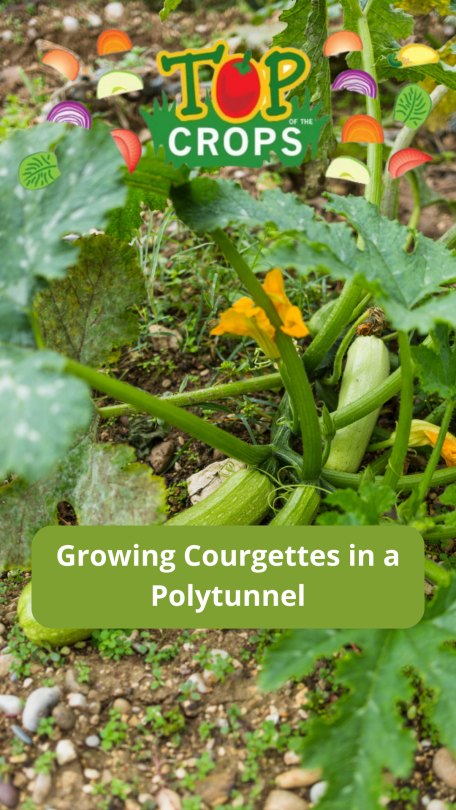Welcome to the top of the crops! Today you will be learning how to grow courgettes in a polytunnel.
Courgettes are a great choice for growing in a polytunnel, and even a plant or two can offer abundant yields from the middle of summer right through to autumn.
Courgettes, also known as zucchini, are the fruits of certain types of Cucurbita pepo. They are a specific type of summer squash, and there are a number of different varieties to choose from.
It descends from squash that were first domesticated in Mesoamerica thousands of years ago, but the courgette as we know it today was bred in Milan in the late 19th Century.
Courgettes are smaller and immature fruits and the fruits of these varieties and some closely related ones are often called 'marrows' when fully grown.
| JAN | FEB | MAR | APR | MAY | JUN | JUL | AUG | SEP | OCT | NOV | DEC | |
| SOW |  |
 |
 |
|||||||||
| PLANT |  |
 |
||||||||||
| HARVEST |  |
 |
 |
 |
If you would like to grow courgettes then of course one of the first things to think about is where you should place these plants. Courgettes can be grown outside in summer in the UK, but they may also be grown in a polytunnel garden or another undercover growing area.
They can be grown in the ground, in raised beds, or in pots as long as their basic growing needs are met. When choosing where to grow courgettes always remember that they need:
A warm, sheltered spot in full sun.
Rich, fertile soil or potting mix, that is moist yet free-draining.
To grow courgettes you will need:
Courgette seeds of your chosen variety.
A suitable growing location. (A suitable container and potting mix if you plan on container growing).
Seed starting potting mix, small pots or soil blocks and perhaps a propagator when starting seeds indoors.
Facility to water your crop.
A trowel/space for planting out.
Organic materials for mulch and feeding.
Secateurs or a garden knife for harvesting.
There are a huge number of different types and varieties of courgette to choose from, and that is before you even begin to consider other closely related summer squash...
All the different types have very similar growing requirements and care needs, but they differ greatly in their appearance, size and growth habits. Some are much larger and more sprawling than others, while some are much more compact plants. Some have spines, while others do not. Some are more disease resistant than others.
The fruits can vary greatly in appearance too. Many are long and thin, in shades of green. But there are also round and ribbed varieties, and some that are yellow, or striped. Some are also ornamental as well as producing food, and some have attractive silvering or mottling on their leaves.
When choosing courgette seeds, you will first have to decide whether you would like to go for hybrid varieties, which often have a better disease and pest resistance, or heritage varieties from which you will be able to collect seed to plant next year. Choosing heritage varieties can be a good choice for a more sustainable polytunnel garden.
We will take a look at some varieties to consider a little later in this guide. You can either purchase courgette seeds (the cheaper and more eco-friendly and sustainable choice) or purchase young plants in the spring.
Fortunately, it is not at all challenging to grow your own courgettes at home. So these can be a great choice for beginners as well as more experienced gardeners.
Courgette seeds are usually sown indoors in the UK and in other cool temperate climate regions. They can also be direct sown in the garden where they are to grow (see below) but indoors sowing is more likely to meet with success, since warmth is needed for successful seed germination.
To germinate successfully, courgettes need temperatures of between 18 and 21 degrees C.. So a heated propagator, though not essential, can improve germination rates and speed of germination.
Sow each seed individually, into its own small pot or soil block with a suitable seed starting growing medium. The seeds should be placed on their sides, and to a depth of around 1cm or a little deeper.
Remove the seedlings from the propagator once they emerge and place them indoors in a warm and bright location, and then they can be hardened off and planted out once all risk of frost has passed in the area where you live.
Seeds can also be sown outdoors where they are to grow in late May or early June, once the soil has warmed. However, note that when direct sowing, germination rates can be more patchy and young seedlings will be very vulnerable to pests such as slugs and snails.
Plant a couple of seeds per sowing station, around 2.5cm deep, and water them in well. If more than one seed emerges, thin to leave the strongest one.
It is also a good idea to cover the planting area with a cloche to warm the soil. You might create a hot bed to plant into, as courgettes will really enjoy the conditions a hot bed can provide.
Make sure to harden off courgettes sown indoors before you plant then out into your polytunnel or place them elsewhere in your garden.
You can plant out courgettes you have grown from seed or young plants you have purchased for the purpose from late May or early June. Make sure there is no longer any risk of frost when you do so.
Remember that eventually, most courgettes will need to be around 90cm or so apart and most courgettes will need around 1m square of space. So make sure you do not plant courgettes too close together.
Carefully make a planting hole in a slightly raised mound of soil enriched with compost or other organic matter at the centre of your chosen growing area, and place your young courgette plant. Planting on a slight mound allows water to drain away from the base of the stems. Firm it gently into place, water it in well, and add an organic mulch around the plant.
You can reduce the space requirements for more vigorous and sprawling courgettes somewhat by providing an encircling structure like a tomato cage. This will allow the plants to grow more vertically. It is a good idea, if you plan on incorporating ideas such as these, to place these before transplanting your seedlings, so as not to disturb plant roots or accidentally damage the plants.
If growing in a container, place the plant at the centre of a pot that is at least 45-50cm across, filled with a good quality, peat-free multipurpose potting mix.
Courgettes can be ready to harvest from midsummer and if you harvest regularly, you can often keep harvesting from the plants right up until the first frosts. Courgettes should be picked when they are young for the best flavour and texture. Pick them when they are around 10 - 12.5cm long.
Courgettes can be very productive plants, so much so that you may even end up with a glut and wonder what to do with all your courgettes. Fortunately, there are plenty of great courgette recipes to consider to use up courgettes from your garden.
You can keep courgettes in your fridge for a few days. You can also freeze courgettes for later use, or dry them, or use them in a range of canned preserves such as chutneys and pickles, for example.
Courgettes are not challenging to care for, but you do need to make sure that they get the water and nutrients they need.
Water courgettes regularly, especially when growing in containers, and make sure that the soil or growing medium remains consistently moist but not waterlogged. Make sure that excess water can drain away freely and always water below, trying not to wet the foliage, flowers or fruit.
For best results, feed your courgette plants once a fortnight or so with a high potassium, organic liquid plant feed such as comfrey tea as soon as the plants first fruits begin to form.
Lay a good, thick covering of organic matter such as homemade compost or well-rotted mature around the courgette plants in order to retain soil moisture and suppress weed growth to a degree. But make sure that the mulch does not touch the stem at its base or it may rot.
Prune off any leaves that are damaged or diseased, and also judiciously remove the odd leaf here and there to let more sun reach ripening fruits.
Courgette varieties with an award of garden merit from the RHS, listed below, are a good place to begin when looking for courgettes suitable for your garden.
‘Astia’
‘Bambino’
‘Defender’
‘Early Gem’
‘El Greco’
‘Firenze’
‘Jaguar’
‘Jemmer’
‘Lorea’
‘Orelia’
‘Parador’
‘Patio Star’
‘Royal Flush’
‘Syros’
‘Tristan’
‘Tuscany’
‘Venus’
‘Yolanda’
Courgettes are often hassle free, but as with all crops, there are certain things that can go wrong when you try to grow them in your garden. Some of the most common issues are outlined below.
If courgettes are not producing fruits, this may be due to:
Immaturity – the plants may still just be too young and small.
Plants producing only male flowers. This is normal early in the season but low temperatures, lack of sunshine and other stress can cause this preponderance of male flowers to continue.
Poor pollination or a lack of pollination. Insects may not have been able to reach the plants. If pollinators are not around, and you do not attract them into your space, you may need to take pollination into your own hands.
Failure to pick fruits regularly. If you don't harvest courgettes regularly, new fruits will not be produced. Hidden fruits maturing may mean that you do not think any fruits have formed.
Slugs and snails can also be a problem for courgettes, especially during their early growth. So make sure that you boost biodiversity to ensure natural predation keeps the numbers of these pests in check, and protect plants with physical barriers where necessary.
Poor pollination can also cause fruits to rot at the flower end before they grow very large. But fruits can also rot as a result of a fungal infection.
One common fungal infection of courgettes is powdery mildew, which mostly affects the leaves and stems, giving them a white, dusty coating. Plants that are not getting enough water will be particularly prone to this problem, so make sure you water to keep the soil consistently moist. It also helps to maintain good airflow between your plants.
Grey mould is another fungal infection that can sometimes infect courgette plants. Again, plants that do not have the right environmental conditions and care are most susceptible.
Courgettes can benefit from the warm and sheltered environment a polytunnel can provide. But make sure that you water well, setting up a good irrigation system, and ensure good ventilation through the summer months.
Control pests and increase yields by companion planting. Beans make good companions for courgettes as nitrogen fixers, as long as they do not shade them out. Nasturtiums are an excellent trap crop for many pests that can plague these plants. And radishes and onions also help with pest control when placed close to courgette plants.
BBC Good Food. (n.d.) Courgette Recipes. BBC. [online] Available at: https://www.bbcgoodfood.com/recipes/collection/courgette-recipes
